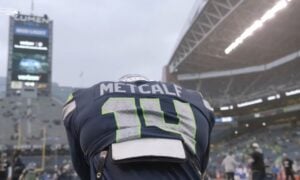There’s one more NFL Draft study I wanted to get to before Thursday night kicks off. The Pittsburgh Steelers are in the unique spot of picking at the top of the second round, 32nd overall (the Miami Dolphins forfeited their first round pick, meaning there’s only 31 first round selections) thanks to the Chase Claypool trade last season.
The first pick of the second round is an interesting spot. Instead of the usual draft craziness, there’s a lull. A chance for each team to catch their breath, review their board, and plan out a Day Two strategy. Naturally, it’s led many to wonder about the potential of Pittsburgh trading out of #32. There’s more time to review and digest offers, to look over the board, and for Omar Khan and company to figure out what they want to do. On paper, it makes sense.
So what’s the reality? How often does the first pick of the second round get dealt? That’s what I wanted to look at. To be clear, in most drafts, that is 33rd overall because most drafts have the normal top 32 picks.
In order to try to make that 33rd pick relative, I’m comparing it to how often the #32 pick (last of the first round) and #34 pick (second pick of the second round) get traded to see if there’s an increase/decrease with the picks that surround it. Under the theory that maybe teams are more likely to trade up into the first round to get that fifth-year option or teams are more likely to trade to #34 if they realize the team at #33 doesn’t want to give it up and knows exactly who they want to take.
One last thing to note that made data collection a little tricky. I’m only interested in picks that were traded once the draft got started, not picks that were traded days or weeks beforehand. That’s a different scenario the Steelers aren’t dealing with right now. So I may have noted below picks that were dealt but not on draft day and those ultimately receive a “no trade” from me.
I am using the last ten draft classes to collect data. The results below:
| Year | Pick #32 | Pick #33 | Pick #34 |
|---|---|---|---|
| 2022 | Traded | Traded | Traded |
| 2021 | Not Traded | Not Traded | Not Traded |
| 2020 | Not Traded | Not Traded | Not Traded |
| 2019 | Not Traded | Not Traded | Not Traded |
| 2018 | Traded | Not Traded | Not Traded |
| 2017 | Not Traded | Not Traded | Traded |
| 2016 | Traded* | Not Traded* | Not Traded* |
| 2015 | Not Traded | Traded | Not Traded |
| 2014 | Traded | Not Traded | Traded |
| 2013 | Not Traded | Not Traded | Traded |
*Picks #31, #32, and #33 after the New England Patriots forfeited their 1st round pick
So those are the numbers. What’s the final tally? Here’s how often each pick was dealt over the ten classes.
#32 – Traded 40% of the time (four times)
#33 – Traded 20% of the time (two times)
#34 – Traded 40% of the time (four times)
So the last pick of the first round and the second pick of the second round were each traded four times. The first pick of the second round, the one the Steelers hold this year, was dealt just twice, though it happened last season when the Detroit Lions moved up from 32 to 12.
This study clearly isn’t an exact science and probably isn’t as fruitful as I had hoped when I first thought of the idea. The data does say #33/first pick of the second round isn’t traded as often as you might think. It seems many times, the team holding that pick prefers to keep it, targeting exactly who they want at that spot, a potential first rounder who slipped a bit.
Clearly, this history doesn’t mean the Steelers will or won’t trade the pick. Omar Khan won’t be swayed by what past teams did or didn’t do. But these numbers illustrate odds are, he’ll keep the pick and turn the card in at #32.








